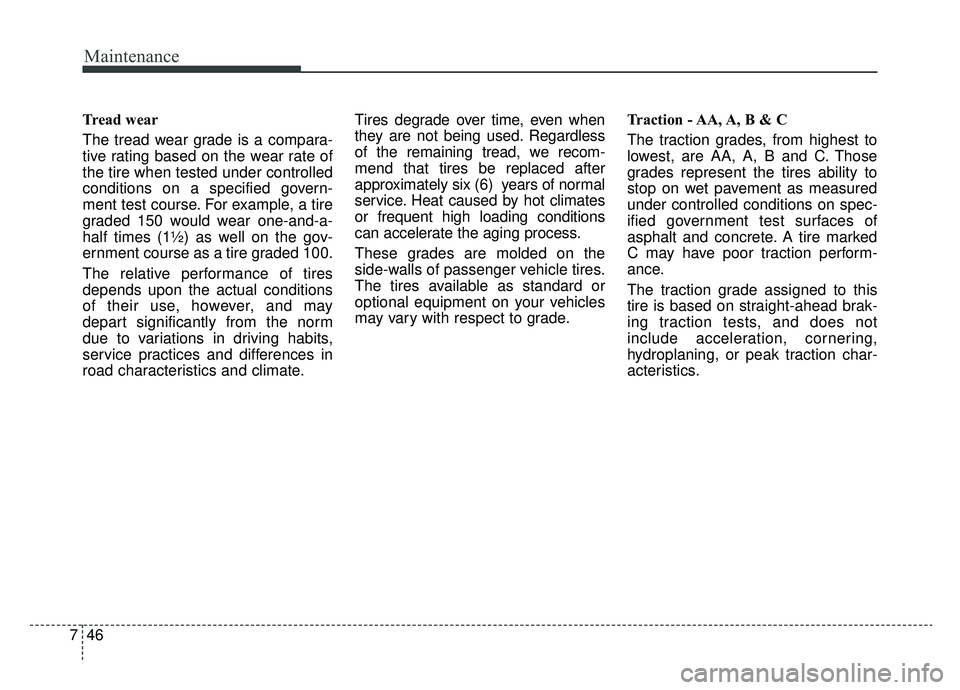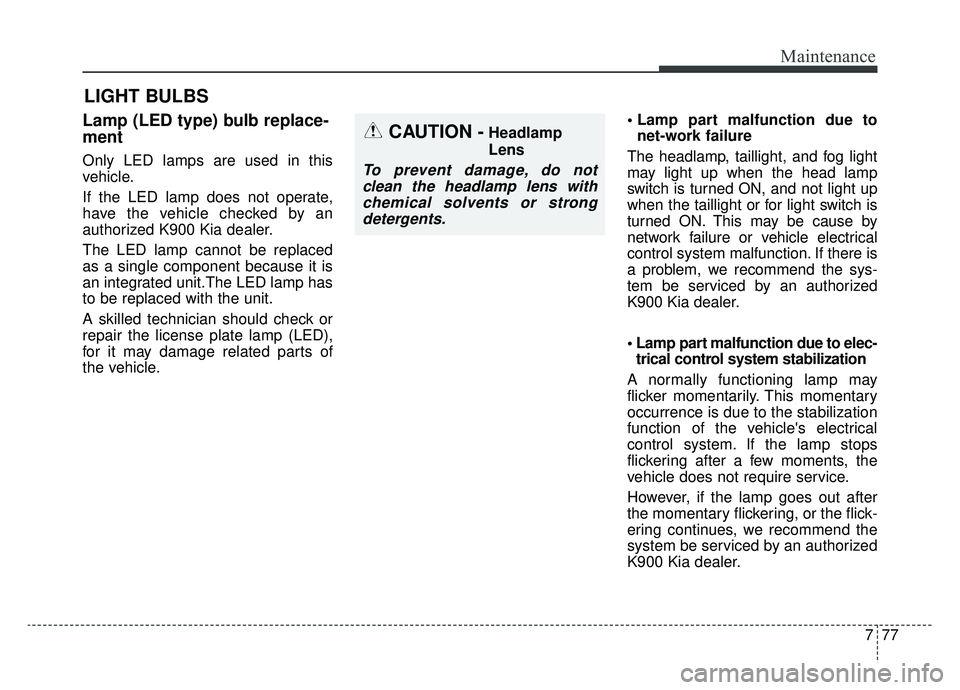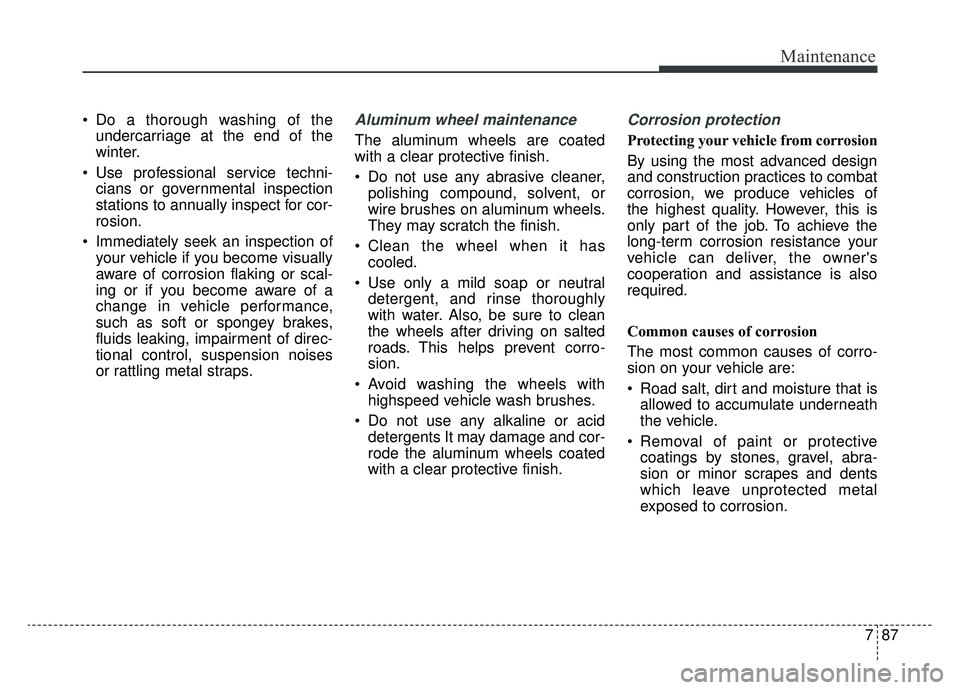Page 467 of 580

713
Maintenance
Normal Maintenance Schedule - Turbo Models (CONT.)
Number of months or driving distance, whichever comes first
Months1224364860728496108120132144156168180
Miles×1,00061218243036424854606672788490
Km×1,000102030405060708090100110120130140150
Intercooler, in/out hose,
air intake hoseLambda II 3.3L T-GDIIIIIIIIIIIIIIII
Cooling system---I-I-I-I-I-I-
Automatic transaxle fluidNo check, No service required
Differential oil (rear) *5-----I-----I---
Differential oil (front) (AWD) *5-----I-----I---
Transfer case oil (AWD)No check, No service required
Vapor hose, fuel filler cap and fuel tank-I-I-I-I-I-I-I-
Fuel tank air filter *4-I-I-I-I-I-I-I-
MAINTENANCEINTERVALS
MAINTENANCE
ITEM
I : Inspect and if necessary, adjust, correct, clean or replace.
R : Replace or change.
*
4: Fuel tank air filter are considered to be maintenance free but periodic inspection is recommended for this maintenance sched- ule depends on fuel quality.
*
5: Front/rear differential oil should be changed anytime they have been submerged in water.
Page 469 of 580
715
Maintenance
Maintenance Under Severe Usage Conditions - Turbo Models
The following items must be serviced more frequently on cars normally used under severe driving conditions. Refer
to the chart below for the appropriate maintenance intervals.
R : Replace I : Inspect and, after inspection, clean, adjust, repair or replace if neces\
sary
MAINTENANCE ITEMMAINTENANCEOPERATIONMAINTENANCE INTERVALSDRIVING
CONDITION
Engine oil and
engine oil filterLambda II 3.3L T-GDIREvery 3,000 miles (5,000 km) or 6 monthsA, B, C, D, E,
F, G, H, I, J, K
Air cleaner filterIMore frequentlyC, E
Spark plugs RMore frequentlyA, B, F, G, H, I, K
Automatic transaxle fluidREvery 60,000 miles (100,000 km) A, C, D, E,
F, G, H, I, J
Front brake disc/pads, calipersIMore frequentlyC, D, E, G, H
Rear brake disc/padsIMore frequentlyC, D, E, G, H
Parking brakeIMore frequentlyC, D, G, H
Steering gear box, linkage & boots/
Lower arm ball joint, upper arm ball jointIMore frequentlyC, D, E, F, G
Page 486 of 580
Maintenance
32
7
Front windshield wiper blade
To inspect or replace the windshield
wiper blades and to prevent damag-
ing the hood, move the windshield
wiper blades to the service position
as follows :
After turning off the engine, move the
wiper switch to the single wiping
(MIST) position within 20 seconds
and hold the switch more than 2 sec-
onds until the wiper blade is in the
fully up position. 1. Raise the wiper arm.
2. Lift up the wiper blade clip. Then
pull down the blade assembly and
remove it.
3. Install the new blade assembly.
ORJ078014
OHM078060
OHM078061
CAUTION - Wiper arms
Do not allow the wiper arm to fall against the windshield,since it may chip or crack thewindshield.
Do not pull wiper arm forward, since arm could chip hoodpaint.
Page 488 of 580

Maintenance
34
7
BATTERY
Battery replacement
The battery is in the trunk. When
replacing the battery, disconnect the
negative (-) cable (1) and remove the
positive (+) battery fuse box (2).
Remove the battery mounting brack-
et (3).
For best battery service
Keep the battery securely mount-
ed.
Keep the battery top clean and dry.
Keep the terminals and connec- tions clean, tight, and coated with
petroleum jelly or terminal grease.
Rinse any spilled electrolyte from the battery immediately with a
solution of water and baking soda.
If the vehicle is not going to be used for an extended time, discon-
nect the battery cables.WARNING- Risk of
explosion
Keep lit cigarettes and
all other flames or
sparks away from the
battery.
The battery contains hydrogen -- a highly
combustible gas which
will explode if it comes
in contact with a flame or
spark.
Keep batteries out of the reach of children
because batteries con-
tain highly corrosive
SULFURIC ACID and
electrolytes. Do not
allow battery acid to
contact your skin, eyes,
clothing or paint finish.
Wear eye protection when charging or work-
ing near a battery.
Always provide ventila-
tion when working in an
enclosed space.
ORJ078015
WARNING
Turn the engine off and wait
until it cools down, or trunk
floor surface may be hot. Wear
gloves when removing the bat-
tery from the trunk.
Page 500 of 580

Maintenance
46
7
Tread wear
The tread wear grade is a compara-
tive rating based on the wear rate of
the tire when tested under controlled
conditions on a specified govern-
ment test course. For example, a tire
graded 150 would wear one-and-a-
half times (1½) as well on the gov-
ernment course as a tire graded 100.
The relative performance of tires
depends upon the actual conditions
of their use, however, and may
depart significantly from the norm
due to variations in driving habits,
service practices and differences in
road characteristics and climate. Tires degrade over time, even when
they are not being used. Regardless
of the remaining tread, we recom-
mend that tires be replaced after
approximately six (6) years of normal
service. Heat caused by hot climates
or frequent high loading conditions
can accelerate the aging process.
These grades are molded on the
side-walls of passenger vehicle tires.
The tires available as standard or
optional equipment on your vehicles
may vary with respect to grade.
Traction - AA, A, B & C
The traction grades, from highest to
lowest, are AA, A, B and C. Those
grades represent the tires ability to
stop on wet pavement as measured
under controlled conditions on spec-
ified government test surfaces of
asphalt and concrete. A tire marked
C may have poor traction perform-
ance.
The traction grade assigned to this
tire is based on straight-ahead brak-
ing traction tests, and does not
include acceleration, cornering,
hydroplaning, or peak traction char-
acteristics.
Page 531 of 580

777
Maintenance
LIGHT BULBS
Lamp (LED type) bulb replace-
ment
Only LED lamps are used in this
vehicle.
If the LED lamp does not operate,
have the vehicle checked by an
authorized K900 Kia dealer.
The LED lamp cannot be replaced
as a single component because it is
an integrated unit.The LED lamp has
to be replaced with the unit.
A skilled technician should check or
repair the license plate lamp (LED),
for it may damage related parts of
the vehicle.
net-work failure
The headlamp, taillight, and fog light
may light up when the head lamp
switch is turned ON, and not light up
when the taillight or for light switch is
turned ON. This may be cause by
network failure or vehicle electrical
control system malfunction. If there is
a problem, we recommend the sys-
tem be serviced by an authorized
K900 Kia dealer.
trical control system stabilization
A normally functioning lamp may
flicker momentarily. This momentary
occurrence is due to the stabilization
function of the vehicle's electrical
control system. If the lamp stops
flickering after a few moments, the
vehicle does not require service.
However, if the lamp goes out after
the momentary flickering, or the flick-
ering continues, we recommend the
system be serviced by an authorized
K900 Kia dealer.
CAUTION -Headlamp
Lens
To prevent damage, do not clean the headlamp lens withchemical solvents or strongdetergents.
Page 541 of 580

787
Maintenance
Do a thorough washing of theundercarriage at the end of the
winter.
Use professional service techni- cians or governmental inspection
stations to annually inspect for cor-
rosion.
Immediately seek an inspection of your vehicle if you become visually
aware of corrosion flaking or scal-
ing or if you become aware of a
change in vehicle performance,
such as soft or spongey brakes,
fluids leaking, impairment of direc-
tional control, suspension noises
or rattling metal straps.Aluminum wheel maintenance
The aluminum wheels are coated
with a clear protective finish.
Do not use any abrasive cleaner,polishing compound, solvent, or
wire brushes on aluminum wheels.
They may scratch the finish.
Clean the wheel when it has cooled.
Use only a mild soap or neutral detergent, and rinse thoroughly
with water. Also, be sure to clean
the wheels after driving on salted
roads. This helps prevent corro-
sion.
Avoid washing the wheels with highspeed vehicle wash brushes.
Do not use any alkaline or acid detergents It may damage and cor-
rode the aluminum wheels coated
with a clear protective finish.
Corrosion protection
Protecting your vehicle from corrosion
By using the most advanced design
and construction practices to combat
corrosion, we produce vehicles of
the highest quality. However, this is
only part of the job. To achieve the
long-term corrosion resistance your
vehicle can deliver, the owner's
cooperation and assistance is also
required.
Common causes of corrosion
The most common causes of corro-
sion on your vehicle are:
Road salt, dirt and moisture that isallowed to accumulate underneath
the vehicle.
Removal of paint or protective coatings by stones, gravel, abra-
sion or minor scrapes and dents
which leave unprotected metal
exposed to corrosion.
Page 557 of 580

Specifications, Consumer information, Reporting safety defects
88
Lubricant VolumeClassification
Rear differential oil1.48 US qt. (1.4 l)HYPOID GEAR OIL API GL-5 SAE 75W85
(SK HK SYN GEAR OIL 75W85)
Front differential oil *3
(AWD)0.74 US qt. (0.7 l)HYPOID GEAR OIL API GL-5 SAE 75W/85
(SK HK SYN GEAR OIL 75W85)
Transfer oil
(AWD)Gear/ Clutch0.60 US qt. (0.57 l)
SHELL TF 0870B
Actuator0.26 US qt. (0.25 l)
FuelGasoline Engine81.4 US qt. (77 l)Refer to Fuel requirements in chapter 1
*1: Refer to the recommended SAE viscosity numbers on the next page.
*2: Engine oils labeled Energy Conserving Oil are now available. Along with other additional benefits, they contribute to fuel economy by reducing the amount of fuel necessary to overcome engine friction. Often, these improvements are difficult to measure in everyday driving, but in a year’s
time, they can offer significant cost and energy savings.
*
3: Regardless of oil change intervals, replace oil immediately if Rear-Differential or Front-Differential is submerged.
*4: If the ACEA A5 oil is not available in your country , you are able to use API service SM/ILSAC GF-4 engine oil.
*5: If the API SM engine oil is not available, you can use API SN or above.
*6: If the ILSAC GF-4 engine oil is not available, you can use ILSAC GF-5 or above.